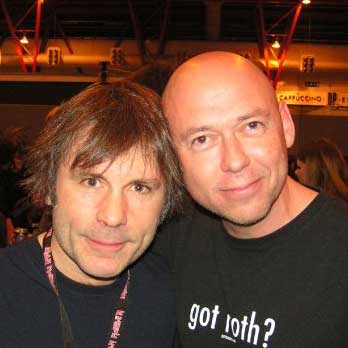How Back In Black brought AC/DC back from the dead
The death of AC/DC’s frontman Bon Scott looked like it might deal a fatal blow to the band as well. But they got a new singer and made a career-rejuvenating record that became the biggest-selling rock album of all time: Back In Black
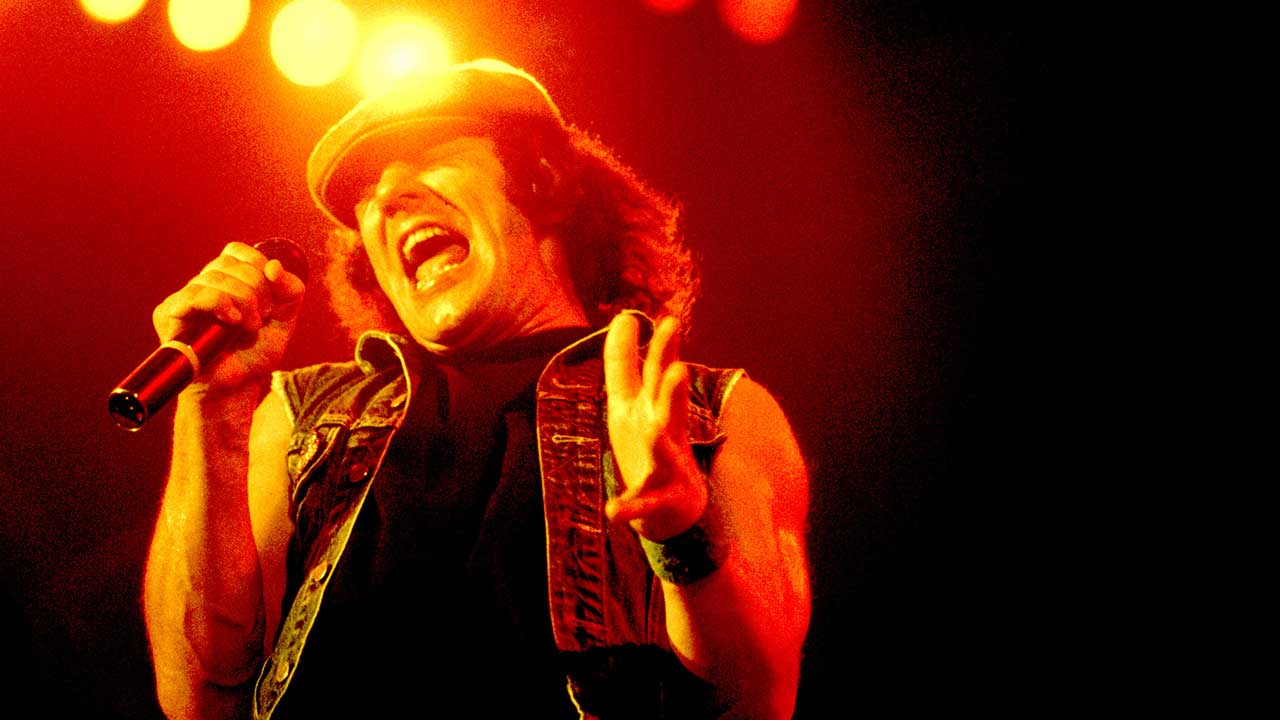
For Angus Young, the pre-show ritual was the same as it had always been. In the dressing room backstage at the Palais des Expositions in the Belgian city of Namur, AC/DC’s lead guitarist changed out of jeans and T-shirt and put on his schoolboy uniform, went for a piss, and had one last cigarette to take the edge off his nerves. But this was no ordinary gig.
On this evening, June 29, 1980, AC/DC were about to perform in public for the first time with their new singer, Brian Johnson. And in the last few minutes before going on stage, as Angus looked around the room, he could see the tension in Johnson’s face.
“He was shitting himself,” Angus said.
Johnson had big shoes to fill. The man he’d replaced, Bon Scott, had been a great rock’n’roll singer and charismatic frontman, a free-spirited hellraiser whose easy charm earned him the epithet ‘Bon The Likeable’. Following Bon’s death in February that year, the band had pushed on with Johnson to make the album Back In Black, of which Angus later said: “When I first heard it in all its glory, I thought: ‘Fuck, it’s magic!’”
But on that warm summer evening in Namur, with the release of the album still a few weeks away, Johnson was a worried man as he waited for show time, wondering how AC/DC fans would react to him, especially when he was singing the old songs, Bon’s words.
It was only when he got on stage and looked out into the audience that he realised how much those fans were rooting for him. In the audience he saw a banner raised aloft, on which it was written: ‘R.I.P. Bon Scott. Good Luck Brian.’ “That,” he recalled, “just lifted me.”
There were moments during the show when all of that anxiety and adrenalin got the better of him.
Sign up below to get the latest from Classic Rock, plus exclusive special offers, direct to your inbox!
“It was a very traumatic night,” he admitted. “I was so nervous.”
Halfway into the set, he had a brain-freeze and sang the same lyrics to two songs. “I thought: ‘Oh God, what have I done?’”
For that he received a bollocking from rhythm guitarist Malcolm Young, Angus’s elder brother. “Malcolm looked at me and went: ‘What the fuck was that?’”
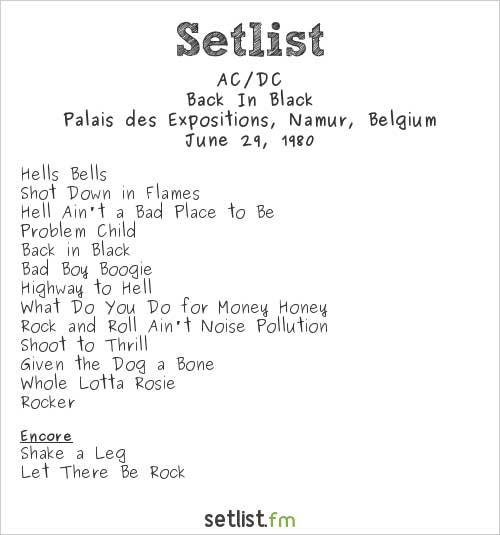
It was a baptism of fire, but Johnson got through it. He won the respect of that audience by singing his balls off, and by being his own man. The flat cap he wore was a sign of his working-class roots in the North East of England, and his on-stage demeanour was different to Bon’s; Johnson was a cajoling, fist-shaking rabble-rouser, but without the macho swagger than Scott had, or the glint of craziness that was always in his eyes.
Johnson also knew from the start how the band worked on stage, ceding the centre ground for Angus to run amok. That night, AC/DC performed seven songs from Back In Black, beginning with album opener Hells Bells. The set ended with Let There Be Rock – significantly, the last song Bon ever sang on stage, just five months earlier, at Southampton Gaumont on January 27, 1980.
Johnson later said of the Namur show: “We had enough spirit to cover up any mistakes.” On a deeper level, there was also a feeling within the band that they had a spirit watching over them. As Angus said in the first days after their new singer had joined them: “We still think Bon’s around.”

Bon Scott had known, in his last days, that AC/DC were on to something big. Their 1979 album Highway To Hell was the band’s first million-seller, and in the early days of January 1980, when work began on new songs in London, he was buzzing.
These new songs were demoed by Angus and Malcolm, with Bon playing drums, as he had done in his first groups back in Australia, and he was convinced that they had the makings of an album that would be even bigger than Highway To Hell. In a phone call to his mother Isa in Australia, he had told her, “This one is going to be it!”
It was only a few days after that call – on February 19, 1980 – that Bon was found dead in East Dulwich, London. He had been out drinking with friends the previous night. Rumours suggested that he might also have taken heroin. In the official inquest, the coroner’s report cited ‘death by misadventure’. Bon was just 33. It was at Bon’s funeral, in his home town of Fremantle in Western Australia, that his father Chick urged Malcolm and Angus to carry on with the band.
On April 1, Johnson, then aged 32, formerly of glam rock band Geordie, was announced as AC/DC’s new singer. The place where the band created their comeback album was far removed from the cold and grey of London and the bad vibes around Bon’s death. Nassau, on the island of New Providence in The Bahamas, was a tropical paradise.
As Johnson would tell Record Mirror: “Actually it’s quite difficult recording in the Bahamas. All you want to do is lounge on the beach. And you can’t get a decent pint of beer.” He added, with tongue in cheek: “Somehow we managed.”
It’s difficult recording in the Bahamas. All you want to do is lounge on the beach
Brian Johnson
What drew the band to Nassau was the calibre of Compass Point Studios, a world-class facility that had been established by the founder of Island Records, Chris Blackwell. According to Tony Platt, the engineer working on the album alongside producer Robert ‘Mutt’ Lange, it was also beneficial for the band to be in such a remote location, away from all the distractions of London or Sydney.
“That helped to bring everyone together,” Platt said.
In the tracks laid down in Nassau, there was something different to previous AC/DC albums, and not only because they had a new singer. While the music was anything but subtle, the change in it was. While the essence of AC/DC – the hard riffing, the heavy grooves – remained intact, the tone had shifted a little. It was rock’n’roll, but with more of a heavy-metal edge. And what Mutt Lange had begun with the band on Highway To Hell – adding a touch of sheen, while retaining maximum power – was brought into full effect.
The sound was huge, and at the highest end of it was Johnson’s voice, pushed to its limit. Some of those tracks were as simple as they come: shoot-from-the-hip numbers such as Have A Drink On Me, What Do You Do For Money Honey, Given The Dog A Bone and the frantic Shake A Leg.
Elsewhere, a little more sophistication came into play: the title track, with its ticking-time-bomb intro and twisting riffs, the slow-burning Let Me Put My Love Into You, and Shoot To Thrill with its funky breakdown. You Shook Me All Night Long was a rock’n’roll song made for radio, with its ringing intro, hooky riff, walloping groove and shout-itout-loud chorus. And in Hells Bells there was an epic feel, a sense of gravitas that AC/DC had never had before, with its tolling bell leading into a slow, mighty riff that was described as “ominous” by Malcolm and “mystical” by Angus.
As Angus confirmed in a 1991 interview, some lyrics written by Bon were used in the new songs. In other songs there were echoes of his spirit and sense of humour. Just as Bon had poked fun at religion in Let There Be Rock and Highway To Hell, so Brian delivered a Christian-baiting one-liner in Hells Bells: ‘If good’s on the left, then I’m sticking to the right!’
In a similar vein, the bluesy boogie Rock And Roll Ain’t Noise Pollution – the last track recorded for the album, written on the spot in around 15 minutes – had an intro in which Brian did what he called “this Southern preacher thing”, just talking off the top of his head and hailing with missionary fervour the life-affirming power of rock’n’roll.
With the album completed in six weeks, they knew what they had was dynamite. Atlantic Records knew it too. The only problem, as the label saw it, was the band’s idea for the album cover – all black, with the AC/DC logo and album title the only detail. It was suggested by Atlantic that this would not be good for business. But the band would not yield.
As Angus put it: “The whole Back In Black album was our dedication to Bon. That’s why the album cover was pure black, and why the album starts with a bell ringing, something sombre and different to anything else we’d done.”

In the first days of the Back In Black tour, with Namur the first of six low-key warm-up gigs in Belgium and Holland, there was another memorable moment for Johnson. He met a Dutch fan with a tattoo of Bon Scott on his arm.
“Bon was my hero,” the fan said. “But now he’s gone I wish you all the luck in the world.”
Johnson later recalled the profound effect those words had on him. “I just stood there shaking,” he said.
The band were in Canada, in the first week of a North American tour, when Back In Black was released there, on July 25, 1980. For one British writer who reviewed the album, there were mixed emotions. Phil Sutcliffe had been a supporter of AC/DC since 1976, and had a great affection for the guys in the band, Bon in particular.
In his review for Sounds, Sutcliffe awarded Back In Black four out of five stars, but stated in memory of Bon: “The ecstasy with which I expect to greet a new AC/DC album just wasn’t possible this time.” Moreover, he dismissed Brian Johnson as a “copy” of Bon. For all that, Sutcliffe concluded: “Back In Black remains a genuine, excellent AC/DC album.”
Two other leading critics had no such reservations. Rolling Stone’s David Fricke declared the album a masterpiece and a milestone in rock. “Back In Black is not only the best of AC/DC’s six American albums,” he wrote. “It’s the apex of heavy metal art: the first LP since Led Zeppelin II that captures all the blood, sweat and arrogance ofthe genre. In other words, Back In Black kicks like a mutha.”
In Record Mirror’s review – headlined: ‘POWER IS RESTORED’ – Robin Smith wrote: “The resurrection shuffle starts here. Brian was the perfect choice, possessing an almost uncanny feel for the band’s songs."
In Smith’s feature on AC/DC in the July 26 edition of Record Mirror, Johnson said: “Bon is still around and watching. At night in my hotel room I had proof that he was there in some form. I know that he approves of what the new line-up is trying to do. He didn’t want the band to split up or to go into a long period of mourning. He wanted us to build on the spirit he left behind.”
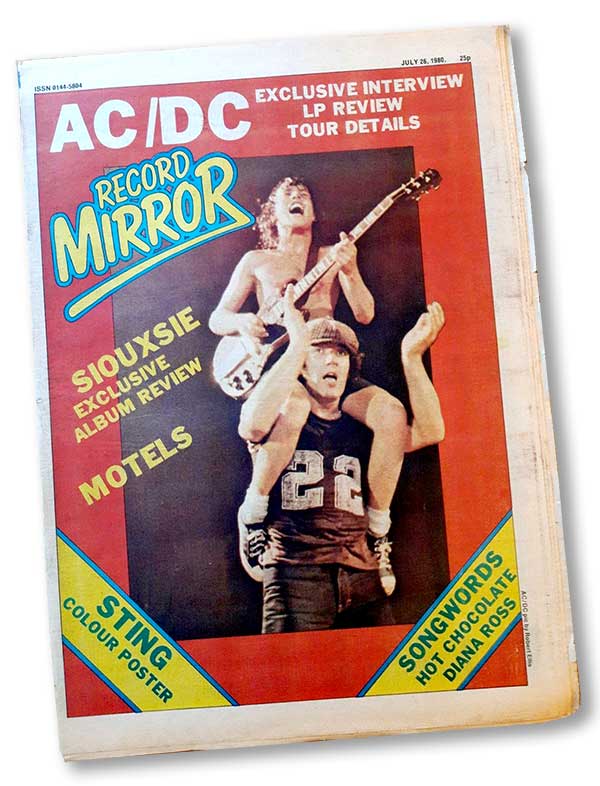
In that interview, Johnson opened up to a remarkable degree, expressing his sorrow over Bon’s death.
“It’s strange how rock music breeds ecstasy and tragedy,” he mused. “You build up that great feeling every night when you go on stage, and then suddenly death strikes in the strangest form. The truth of the matter was that Bon died because he vomited when his neck was twisted, and he choked. That poor boy was loved by thousands of people worldwide.”
He also spoke with great humility about his role in the band. “I hope that I’ve been accepted by AC/DC fans,” he said. “They want the band to go on as well. Certainly I’ve had no letters or phone calls saying get out.”
On August 1, at the Palladium in New York City, AC/DC’s support act, for one night only, was Def Leppard, whose singer Joe Elliott was celebrating his twenty-first birthday. The young British band, then promoting their debut album On Through The Night, had opened for AC/DC a year earlier on the Highway To Hell tour. They also shared a manager with AC/DC, Peter Mensch, and as a result they had been among the first people, outside of AC/DC’s inner circle, to hear Back In Black.
Joe Elliott recalls now: “Mensch came on our tour bus with a cassette of the album, and when we heard Hells Bells we all sat there going: ‘Holy crap!’ It was almost too fucking good.”
When Elliott met Johnson for the first time, in a hotel lobby ahead of the New York show, the conversation they had seemed a little weird to Joe.
“Brian was a seasoned veteran,” he says. “Geordie had a few hits in the early seventies, and after that he’d done years in clubs in the North East. But this was one of his first gigs in the States, and I’d already done a ton of gigs out there. So he took me to one side and said: ‘What the hell am I supposed to do?’ I was just a kid, still learning my craft, but I told him: ‘Just be yourself, man. It’s all you can do.’”
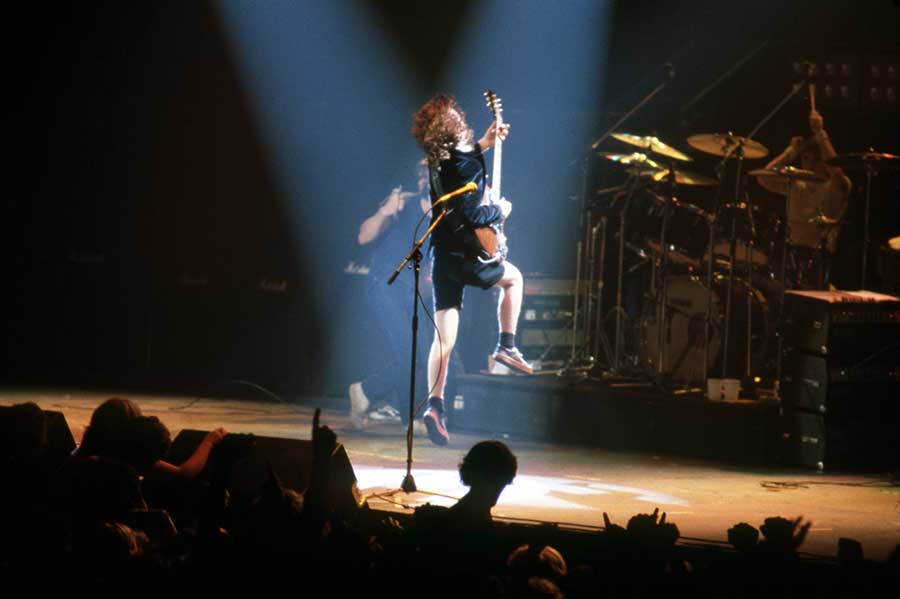
That night, when Elliott watched AC/DC’s performance from the side of the stage, he still had his doubts as to whether Johnson could pull this off. “What they had with Bon Scott was this cocky motherfucker, bare chest, all attitude. And then you’ve got the guy who looks like fucking Andy Capp singing for them! My initial impression was: ‘Hmm, not sure about this. But as it turned out, Brian was perfect for that band, and maybe the only guy who could have done it. He had the voice for it. And that record – it was just amazing."
In what was an emotional and triumphant homecoming, AC/DC performed seven shows in Australia, and at the third date in Sydney on February 23 there was a moment that Brian Johnson would remember for the rest of his life. Bon’s mother Isa was a guest at the show, and afterwards she said to Brian: “Our Bon would have been proud of you, son.”
For Brian, there could be no greater validation. The tour ended with two shows at the Sidney Meyer Music Bowl in Melbourne on February 27 and 28. The last of those shows came a year and one day since the last gig with Bon. By this time, Back In Black had sold more than three million copies in the US alone.

The resurrection of AC/DC with Back In Black was arguably the greatest comeback in the entire history of rock’n’roll. Out of their darkest hour had come a heroic victory.
Guns N’ Roses guitarist Slash was just 15 years old when Back In Black was released. Many years later, he recalled the impact that record had on him, and spoke of it as a triumph not just for Brian Johnson and AC/DC, but also for rock music, period.
“Back In Black saved rock’n’roll,” Slash said. “It was the defining rock record of that time, and it just exploded! AC/DC was always a great band, totally genuine. But the miracle of the whole thing was that Back In Black was just a great new record, it was still AC/DC. We all missed Bon, but we let him go and at the same time welcomed and embraced Brian.”
Back In Black saved rock’n’roll. It was the defining rock record of that time
Slash
The key songs from Back In Black – the title song, Hells Bells, Shoot To Thrill and You Shook Me All Night Long – have remained in AC/DC’s live set for decades. Most remarkable of all is the sheer scale of this album’s success. Back In Black is not only the biggest-selling rock album there has ever been – bigger than anything by Led Zeppelin, Pink Floyd, the Rolling Stones or even The Beatles – with more than 50 million copies sold its also the second-biggest-selling album of all time, after Michael Jackson’s Thriller.
In the making of Back In Black, their tribute to Bon, as Angus Young called it, AC/DC dug deep. As Malcolm Young once said: “The emotion in that album, it will be around forever.”
For Joe Elliott, and millions of others who feel the same way, what AC/DC achieved on Back In Black was perfection. “That record sounds as good now, forty years later, as it did the day it was released,” Elliott says. “It’s timeless, and very few records are like that – the first Montrose album, the first Van Halen album, the first Boston album. AC/DC was always about full-on rock’n’roll, based on the blues and Chuck Berry. But with Back In Black they took it up a level, and they blew everybody else out of the water. Without a doubt, it’s one of the greatest rock albums ever made."
The 20 Million Club is Classic Rock's new podcast - and the first episode is all about Back In Black.
Freelance writer for Classic Rock since 2005, Paul Elliott has worked for leading music titles since 1985, including Sounds, Kerrang!, MOJO and Q. He is the author of several books including the first biography of Guns N’ Roses and the autobiography of bodyguard-to-the-stars Danny Francis. He has written liner notes for classic album reissues by artists such as Def Leppard, Thin Lizzy and Kiss, and currently works as content editor for Total Guitar. He lives in Bath - of which David Coverdale recently said: “How very Roman of you!”
